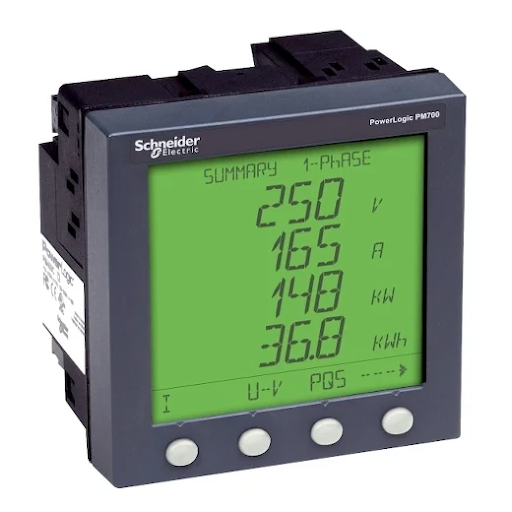Energy monitoring has become one of the most essential tools for industries, commercial facilities, and even large residential setups. As demand for electricity grows and efficiency becomes a top priority, the need for reliable power meters continues to rise. One such reliable and cost-effective solution is the PM710MG Power Meter, a device designed for basic readings and simplified monitoring.
In this guide, we’ll cover everything you need to know about PM710MG Power Meter, including its features, specifications, applications, integration with PLCHMI, and how it benefits modern energy management systems.
The Role of Power Meters in Modern Facilities
Why Power Monitoring is Important
- Accurate Billing: Sub-metering ensures fair allocation of electricity usage among tenants or departments.
- Energy Efficiency: Tracking real-time energy consumption allows organizations to reduce waste.
- Load Management: By understanding load patterns, facility managers can optimize operations.
- System Reliability: Power meters provide insights into performance and identify faults early.
Basic vs Advanced Power Meters
- Basic Meters (like PM710MG): Provide essential electrical data such as voltage, current, power factor, and energy consumption.
- Advanced Meters: Offer detailed analytics, harmonics, waveform capture, and dual Ethernet communication.
For many facilities, a basic meter like the PM710MG is sufficient, cost-effective, and easy to use.
Everything You Need to Know About PM710MG Power Meter
Core Functionality
The PM710MG Power Meter is designed to provide fundamental electrical readings. It is ideal for environments where basic monitoring is enough without the need for complex analysis.
Typical Applications
- Commercial buildings needing sub-metering
- Industrial sites monitoring individual equipment
- Educational institutions tracking utility consumption
- Healthcare facilities needing reliable but simple monitoring
- Residential complexes with distributed loads
Key Features of PM710MG Power Meter
Basic Electrical Readings
The meter provides core parameters such as:
- Voltage (phase-to-phase, phase-to-neutral)
- Current (per phase)
- Power factor
- Active and reactive power
- Frequency
- Energy consumption (kWh)
Easy-to-Read Display
A simple front-panel display allows operators to check readings quickly without needing external devices.
Cost-Effective Monitoring
For organizations that do not need advanced features, the PM710MG offers an affordable yet reliable solution.
User-Friendly Design
Compact design and straightforward setup make it suitable for both small and large facilities.
Integration of PM710MG with PLCHMI
What is PLCHMI?
- PLC (Programmable Logic Controller): Provides automated control of machines and processes.
- HMI (Human Machine Interface): Offers a graphical interface for operators to monitor and control processes.
When combined as PLCHMI, this system enables automation with clear operator interaction.
Why Integrate PM710MG with PLCHMI?
- Centralized Monitoring: Operators can see power data alongside production and machine status.
- Automation Support: PLC logic can act on power data (e.g., shutting down machines when overloading occurs).
- Visualization: HMI dashboards simplify raw electrical readings into intuitive charts and indicators.
- Alerts and Alarms: Facility managers receive real-time notifications of irregularities.
Practical Use Cases of Integration
- Manufacturing Plants: Power data helps adjust operations for efficiency.
- Data Centers: Alerts ensure backup systems respond when power fluctuations occur.
- Commercial Facilities: Visualization helps property managers track tenant usage.
Advantages of PM710MG Power Meter
Simplicity
Its biggest advantage is ease of use. With basic readings, operators don’t need extensive training.
Reliability
The device delivers accurate and consistent measurements without complex setup.
Cost Savings
Because it focuses on essential features, organizations avoid unnecessary expenses.
Compatibility
It can integrate into larger automation systems through PLCHMI, allowing greater flexibility.
Scalability
Multiple meters can be installed across different points in a facility to build a complete monitoring network.
Step-by-Step Guide to Implementing PM710MG Power Meter
Assess Facility Needs
Identify whether the requirement is for detailed power quality monitoring or just basic readings.
Installation
Install the meter at key distribution points where data collection is required.
Calibration
Ensure accurate readings by performing initial calibration according to facility load conditions.
Connect to PLCHMI
Integrate the meter into existing PLC and HMI systems for centralized visualization.
Monitor and Analyze
Use collected data to identify consumption trends and improve efficiency.
Comparing PM710MG with Other Meters
PM710MG vs Advanced Meters
- PM710MG: Basic readings, simple operation, cost-effective.
- Advanced Meters: Complex analytics, harmonic analysis, Ethernet communication, higher cost.
When to Choose PM710MG
- Facilities with limited budgets.
- Sites where only consumption and load distribution need to be tracked.
- Small to medium businesses without the need for advanced diagnostics.
Challenges in Basic Power Monitoring and Their Solutions
Limited Data
Basic meters don’t capture harmonics or waveform distortions.
Solution: Use PM710MG where such features are not necessary, or supplement with advanced meters where required.
Manual Monitoring
Basic meters often require manual data collection.
Solution: Integrate with PLCHMI for automated dashboards and data logging.
Expanding Needs
Organizations may later require more detailed monitoring.
Solution: Deploy PM710MG initially and plan for scalable upgrades in the future.
Future of Basic Power Meters
Increased Integration with Automation
Even simple meters will become smarter, integrating seamlessly with PLCHMI systems.
IoT Connectivity
Basic meters may evolve with cloud-based dashboards for remote monitoring.
Cost-Effective Smart Features
Manufacturers may add selective smart features to basic models while keeping them affordable.
Conclusion
The PM710MG Power Meter is an ideal solution for organizations that need basic readings without the complexity or cost of advanced power monitoring devices. It provides essential data such as voltage, current, power factor, and energy consumption, making it perfect for small to medium facilities, sub-metering, and cost allocation.
When integrated with PLCHMI, the PM710MG becomes even more powerful by providing centralized monitoring, visualization, and automation support. This combination allows facilities to optimize efficiency, prevent overloads, and ensure reliable power management.
In short, if your organization is seeking a and simple scost-effective, reliable, olution for energy monitoring, this is everything you need to know about PM710MG Power Meter—a device built to deliver essential insights with ease.

